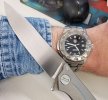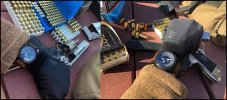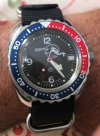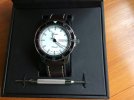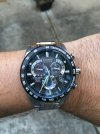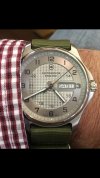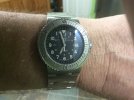-
The BladeForums.com 2024 Traditional Knife is available! Price is $250 ea (shipped within CONUS).
Order here: https://www.bladeforums.com/help/2024-traditional/
You are using an out of date browser. It may not display this or other websites correctly.
You should upgrade or use an alternative browser.
You should upgrade or use an alternative browser.
What watch do you wear?
- Thread starter kershaw22
- Start date
I have been considering starting to wear a watch again and was perusing this thread for ideas. That prompted me to pull out a railroad watch that belonged to my grandfather and which was passed to me by my father. I had assumed the watch was no longer in working condition and I was wondering if there was anyplace in the area that could work on it. However, it turned out that the hour hand just needed to be bent back into position and the watch wound and it is ticking away again. I have no idea how old the watch is, but my grandfather died in 1963. I don't know it I will carry it on a regular basis, but it is in my pocket for today.
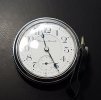

View attachment 1212451 I've got a blue thing going.
I have been considering starting to wear a watch again and was perusing this thread for ideas. That prompted me to pull out a railroad watch that belonged to my grandfather and which was passed to me by my father. I had assumed the watch was no longer in working condition and I was wondering if there was anyplace in the area that could work on it. However, it turned out that the hour hand just needed to be bent back into position and the watch wound and it is ticking away again. I have no idea how old the watch is, but my grandfather died in 1963. I don't know it I will carry it on a regular basis, but it is in my pocket for today.
View attachment 1212217
I was able to open the watch up and check the serial number on the movement. Apparently it was made in 1903. I am going to send it in for servicing and will hopefully keep it in good shape so that I can pass it along with some other family heirlooms when the time comes.
Gary W. Graley
“Imagination is more important than knowledge"
Knifemaker / Craftsman / Service Provider
- Joined
- Mar 2, 1999
- Messages
- 27,790
This one has been great, very easily read with the face a flat black matte finish and no distracting additional lines or reflections
 Untitled by GaryWGraley, on Flickr
Untitled by GaryWGraley, on Flickr
 IMG_7260 by GaryWGraley, on Flickr
IMG_7260 by GaryWGraley, on Flickr
G2
 Untitled by GaryWGraley, on Flickr
Untitled by GaryWGraley, on Flickr IMG_7260 by GaryWGraley, on Flickr
IMG_7260 by GaryWGraley, on FlickrG2
- Joined
- Jan 11, 2006
- Messages
- 1,839
I have been considering starting to wear a watch again and was perusing this thread for ideas. That prompted me to pull out a railroad watch that belonged to my grandfather and which was passed to me by my father. I had assumed the watch was no longer in working condition and I was wondering if there was anyplace in the area that could work on it. However, it turned out that the hour hand just needed to be bent back into position and the watch wound and it is ticking away again. I have no idea how old the watch is, but my grandfather died in 1963. I don't know it I will carry it on a regular basis, but it is in my pocket for today.
View attachment 1212217
The Dueber-Hampden Watch Co. of Canton, Ohio, was created by a merger in 1886. The new company was more significant than its antecedents and produced 4 million watches. In the 1890s, when synthetic rubies became widely available, Dueber-Hampden was the first to mass produce and heavily promote 17-jewel watches. (Seventeen is still the standard for mechanical watch movements, but movements with self-winding mechanisms can use up to 32 jewels.) They produced a line of "railroad grade" watches, some of which were on the approved lists of various railroads.
There is a good short history here with links to some cool mass market advertising from the early 20th century:
https://mb.nawcc.org/wiki/Hampden-Watch-Co
Their watch movements were serial numbered and they kept meticulous production and purchaser records.
On 7 May 1915, the RMS Lusitania was torpedoed and sank with 1,198 passengers and crew off the south coast of Ireland. A passenger washed ashore in October, physically unidentifiable but wearing a Hampden watch, serial number 3,039,347. The Cunard Line contacted the Dueber-Hampden Watch Co. who were able to put them in touch with the owner's family.
Wrist watches, first mass produced in 1902, came into style for men after the First World War. Due to falling sales, Dueber-Hampden went into receivership in 1927. In 1930, Amtorg Trading Corporation purchased the Dueber-Hampden Watch Company together with all of its manufacturing equipment, parts on hand, and work in progress. AMTORG (Амторг, short for Amerikanskaya Torgovlya) was the trade representative of the Soviet Union in the United States, back before the USA and USSR had diplomatic relations. Twenty eight boxcars of machinery and 21 Dueber-Hampden employees went to Moscow to establish the First State Watch Factory. In 1931, the Moscow factory began producing pocket watches with Hampden's twin finger bridge movements, which the Soviets called Type-1. Renamed First Moscow Watch Factory in 1943, old Dueber-Hampden went on to produce Poljot (Полёт, "flight"), top of the line in Soviet watches, and Yuri Gagarin's space watch.

You have a nice old pocket watch, popedandy. It might have collector value — not enough for a new car, but maybe a new iPad. I would take it to a watchmaker for cleaning, lubrication and regulation. Besides being accurate to +/– 15 seconds per week, railroad approved watches had to be easy for a railroad's watchmakers to regulate.
A watchmaker could give you the serial number on the movement and you could look that up online. If you want to keep it, he could advise you on repair work. You have a hunter style watch which once had a cover. It might be possible to put the movement into an intact hunter case, perhaps from another Hampden watch.
Last edited:
The Dueber-Hampden Watch Co. of Canton, Ohio, was created by a merger in 1886. The new company was more significant than its antecedents and produced 4 million watches. In the 1890s, when synthetic rubies became widely available, Dueber-Hampden was the first to mass produce and heavily promote 17-jewel watches. (Seventeen is still the standard for mechanical watch movements, but movements with self-winding mechanisms can use up to 32 jewels.) They produced a line of "railroad grade" watches, some of which were on the approved list of various railroads.
There is a good short history here with links to some cool mass market advertising from the early 20th century:
https://mb.nawcc.org/wiki/Hampden-Watch-Co
Their watch movements were serial numbered and they kept meticulous production and purchaser records.
On 7 May 1915, the RMS Lusitania was torpedoed and sunk with 1,198 passengers and crew off the south coast of Ireland. A passenger washed ashore in October, physically unidentifiable but wearing a Hampden watch, serial number 3,039,347. The Cunard Line contacted the Dueber-Hampden Watch Co. who were able to put them in touch with the owner's family.
Wrist watches, first mass produced in 1902, came into style for men after the First World War. Due to falling sales, Dueber-Hampden went into receivership in 1927. In 1930, Amtorg Trading Corporation purchased the Dueber-Hampden Watch Company together with all of its manufacturing equipment, parts on hand, and work in progress. AMTORG (Амторг, short for Amerikanskaya Torgovlya) was the trade representation of the Soviet Union in the United States, back before the USA and USSR had diplomatic relations. Twenty eight boxcars of machinery and 21 Dueber-Hampden employees went to Moscow to establish the First State Watch Factory. In 1931, the Moscow factory began producing pocket watches with Hampden's twin finger bridge movements, which the Soviets called Type-1. Renamed First Moscow Watch Factory in 1943, old Dueber-Hampden went on to produce Poljot (Полёт, "flight"), top of the line in Soviet watches, and Yuri Gagarin's space watch.

You have a nice old pocket watch, popedandy. It might have collector value — not enough for a new car, but maybe a new iPad. I would take it to a watchmaker for cleaning, lubrication and regulation. Besides being accurate to +/– 15 seconds per week, railroad approved watches had to be easy for a railroad's watchmakers to regulate.
A watchmaker could give you the serial number on the movement and you could look that up online. If you want to keep it, he could advise you on repair work. You have a hunter style watch which once had a cover. It might be possible to put the movement into an intact hunter case, perhaps from another Hampden watch.
Thanks for all the information.
I was able to find a watchmaker who specializes in older timepieces. He said that the watch just needs cleaned, oiled, and adjusted. I'm pretty happy that it is in such great condition.
- Joined
- Jan 4, 2015
- Messages
- 667
Samsung Galaxy watch...
It's been an interesting change from my SKX007!
But I like it.

It's been an interesting change from my SKX007!
But I like it.

toxophilus
Gold Member
- Joined
- May 14, 2015
- Messages
- 561
- Joined
- Sep 13, 2017
- Messages
- 9,113
- Joined
- Jan 13, 2014
- Messages
- 129
Isobrite Afterburner model with high performance, T100 tritium tube technology. It's the only watch which can be read in all levels of light, whether your eyes have become night-adapted or not. Watertight to 200M with, IIRC, a Swiss Ronda movement mated to a ten year battery. I wear mine day and night.
[URL='https://www.google.com/url?sa=i&rct=j&q=&esrc=s&source=images&cd=&ved=2ahUKEwiThdqnwsDlAhUQ7J4KHfNRCqQQjRx6BAgBEAQ&url=https%3A%2F%2Fwww.righttime.com%2Frt%2Farmourlite%2Fiso30031.htm&psig=AOvVaw31M_Im_PDHFZTMeCwbmfMj&ust=1572405419167684']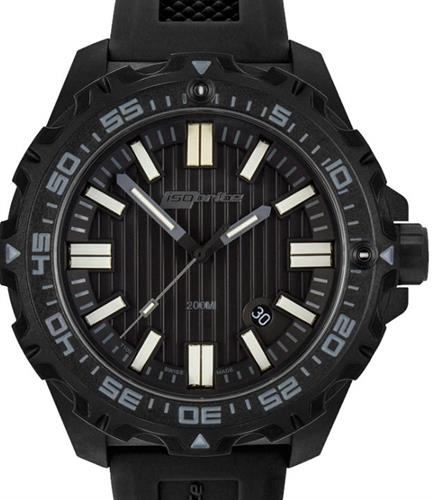 432 × 500
432 × 500
[URL='https://www.google.com/url?sa=i&rct=j&q=&esrc=s&source=images&cd=&ved=2ahUKEwi_muXfwsDlAhXIuZ4KHQhzDgAQjRx6BAgBEAQ&url=https%3A%2F%2Fwww.armourlite.com%2Fiso3003&psig=AOvVaw31M_Im_PDHFZTMeCwbmfMj&ust=1572405419167684'] 1000 × 1000[/URL][/URL]
1000 × 1000[/URL][/URL]
[URL='https://www.google.com/url?sa=i&rct=j&q=&esrc=s&source=images&cd=&ved=2ahUKEwiThdqnwsDlAhUQ7J4KHfNRCqQQjRx6BAgBEAQ&url=https%3A%2F%2Fwww.righttime.com%2Frt%2Farmourlite%2Fiso30031.htm&psig=AOvVaw31M_Im_PDHFZTMeCwbmfMj&ust=1572405419167684']
 432 × 500
432 × 500[URL='https://www.google.com/url?sa=i&rct=j&q=&esrc=s&source=images&cd=&ved=2ahUKEwi_muXfwsDlAhXIuZ4KHQhzDgAQjRx6BAgBEAQ&url=https%3A%2F%2Fwww.armourlite.com%2Fiso3003&psig=AOvVaw31M_Im_PDHFZTMeCwbmfMj&ust=1572405419167684']
 1000 × 1000[/URL][/URL]
1000 × 1000[/URL][/URL]



